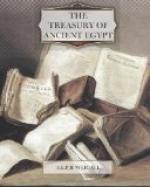Well supplied with food and drink, the senses of the dead man were soothed by a profusion of flowers, which lay withered but not decayed beside the coffin, and which at the time of the funeral must have filled the chamber with their sweetness. Near the doorway stood an upright wooden chest closed with a lid. Opening this, we found it to contain the great ceremonial wig of the deceased man, which was suspended from a rail passing across the top of the chest, and hung free of the sides and bottom. The black hair was plaited into hundreds of little tails, but in size the wig was not unlike those of the early eighteenth century in Europe. Chairs, beds, and other pieces of furniture were arranged around the room, and at one side there were a number of small chests and boxes piled up against the wall. We opened one or two of these, and found them to contain delicate little vases of glass, stone, and metal, wrapped round with rags to prevent them breaking. These, like everything else in the tomb, were new and fresh, and showed no trace of the passing of the years.
The coffins, of course, were hidden by the great casing in which each rested, and which itself was partly hidden by the linen pall. Nothing could be touched for many days, until photographs had been taken and records made; and we therefore returned through the long passage to the light of the day.
There must have been a large number of intact tombs to be found when first the modern interest in Egyptian antiquities developed; but the market thus created had to be supplied, and gangs of illicit diggers made short work of the most accessible tombs. This illegal excavation, of course, continues to some extent at the present day, in spite of all precautions, but the results are becoming less and less proportionate to the labour expended and risk taken. A native likes best to do a little quiet digging in his own back yard and to admit nobody else into the business. To illustrate this, I may mention a tragedy which was brought to my notice a few years ago. A certain native discovered the entrance of a tomb in the floor of his stable, and at once proceeded to worm his way down the tunnel. That was the end of the native. His wife, finding that he had not returned two hours or so later, went down the newly found tunnel after him. That was the end of her also. In turn, three other members of the family went down into the darkness; and that was the end of them. A native official was then called, and, lighting his way with a candle, penetrated down the winding passage. The air was so foul that he was soon obliged to retreat, but he stated that he was just able to see in the distance ahead the bodies of the unfortunate peasants, all of whom had been overcome by what he quaintly described as “the evil lighting and bad climate.” Various attempts at the rescue of the bodies having failed, we gave orders that this tomb should be regarded as their sepulchre, and that its mouth should be sealed up. According to the natives, there was evidently a vast hoard of wealth stored at the bottom of this tomb, and the would-be robbers had met their death at the hands of the demon in charge of it, who had seized each man by the throat as he came down the tunnel and had strangled him.




